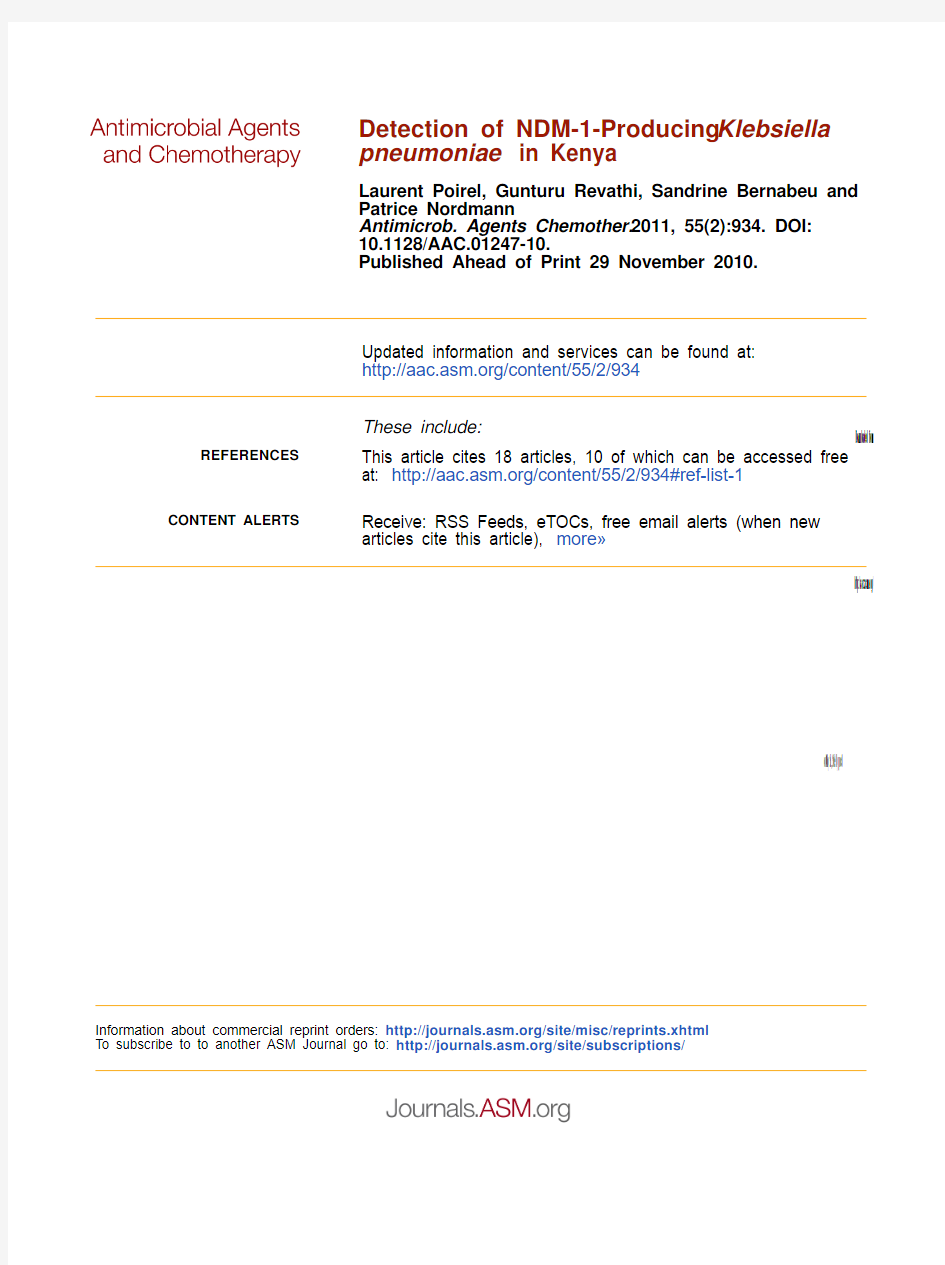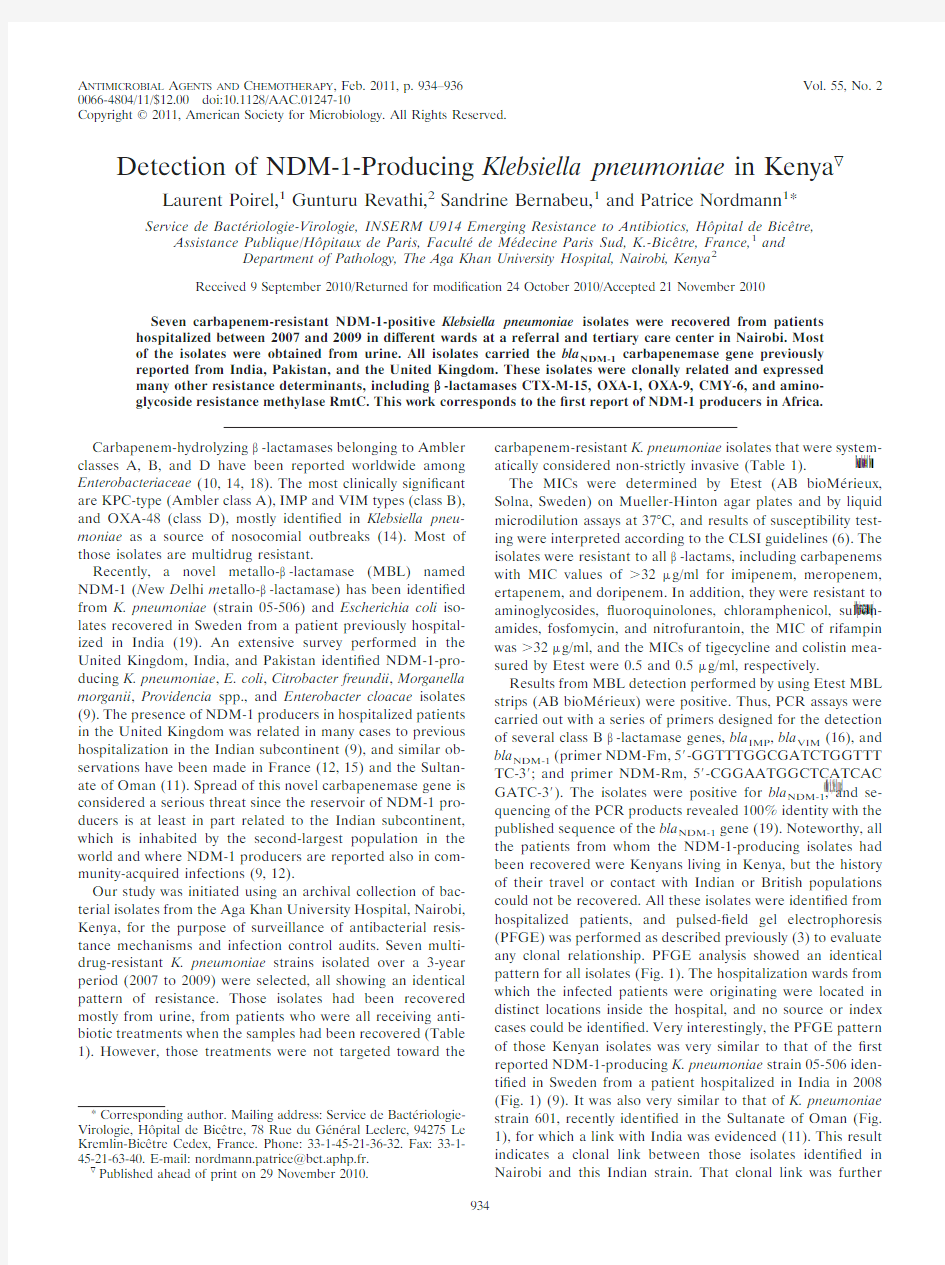Detection of NDM-1-Producing Klebsiella pneumoniae in Kenya


Published Ahead of Print 29 November 2010. 10.1128/AAC.01247-10.
2011, 55(2):934. DOI:Antimicrob. Agents Chemother. Patrice Nordmann
Laurent Poirel, Gunturu Revathi, Sandrine Bernabeu and
in Kenya
pneumoniae Klebsiella Detection of NDM-1-Producing https://www.360docs.net/doc/fe3125612.html,/content/55/2/934Updated information and services can be found at: These include:
REFERENCES
https://www.360docs.net/doc/fe3125612.html,/content/55/2/934#ref-list-1
at: This article cites 18 articles, 10 of which can be accessed free CONTENT ALERTS
more?articles cite this article), Receive: RSS Feeds, eTOCs, free email alerts (when new https://www.360docs.net/doc/fe3125612.html,/site/misc/reprints.xhtml Information about commercial reprint orders: https://www.360docs.net/doc/fe3125612.html,/site/subscriptions/
To subscribe to to another ASM Journal go to: on May 21, 2014 by guest
https://www.360docs.net/doc/fe3125612.html,/Downloaded from
A NTIMICROBIAL A GENTS AND C HEMOTHERAPY,Feb.2011,p.934–936Vol.55,No.2 0066-4804/11/$12.00doi:10.1128/AAC.01247-10
Copyright?2011,American Society for Microbiology.All Rights Reserved.
Detection of NDM-1-Producing Klebsiella pneumoniae in Kenya?Laurent Poirel,1Gunturu Revathi,2Sandrine Bernabeu,1and Patrice Nordmann1* Service de Bacte′riologie-Virologie,INSERM U914Emerging Resistance to Antibiotics,Ho?pital de Bice?tre, Assistance Publique/Ho?pitaux de Paris,Faculte′de Me′decine Paris Sud,K.-Bice?tre,France,1and
Department of Pathology,The Aga Khan University Hospital,Nairobi,Kenya2
Received9September2010/Returned for modi?cation24October2010/Accepted21November2010 Seven carbapenem-resistant NDM-1-positive Klebsiella pneumoniae isolates were recovered from patients
hospitalized between2007and2009in different wards at a referral and tertiary care center in Nairobi.Most
of the isolates were obtained from urine.All isolates carried the bla
NDM-1carbapenemase gene previously
reported from India,Pakistan,and the United Kingdom.These isolates were clonally related and expressed many other resistance determinants,including?-lactamases CTX-M-15,OXA-1,OXA-9,CMY-6,and amino-glycoside resistance methylase RmtC.This work corresponds to the?rst report of NDM-1producers in Africa.
Carbapenem-hydrolyzing?-lactamases belonging to Ambler classes A,B,and D have been reported worldwide among Enterobacteriaceae(10,14,18).The most clinically signi?cant are KPC-type(Ambler class A),IMP and VIM types(class B), and OXA-48(class D),mostly identi?ed in Klebsiella pneu-moniae as a source of nosocomial outbreaks(14).Most of those isolates are multidrug resistant.
Recently,a novel metallo-?-lactamase(MBL)named NDM-1(N ew D elhi m etallo-?-lactamase)has been identi?ed from K.pneumoniae(strain05-506)and Escherichia coli iso-lates recovered in Sweden from a patient previously hospital-ized in India(19).An extensive survey performed in the United Kingdom,India,and Pakistan identi?ed NDM-1-pro-ducing K.pneumoniae,E.coli,Citrobacter freundii,Morganella morganii,Providencia spp.,and Enterobacter cloacae isolates (9).The presence of NDM-1producers in hospitalized patients in the United Kingdom was related in many cases to previous hospitalization in the Indian subcontinent(9),and similar ob-servations have been made in France(12,15)and the Sultan-ate of Oman(11).Spread of this novel carbapenemase gene is considered a serious threat since the reservoir of NDM-1pro-ducers is at least in part related to the Indian subcontinent, which is inhabited by the second-largest population in the world and where NDM-1producers are reported also in com-munity-acquired infections(9,12).
Our study was initiated using an archival collection of bac-terial isolates from the Aga Khan University Hospital,Nairobi, Kenya,for the purpose of surveillance of antibacterial resis-tance mechanisms and infection control audits.Seven multi-drug-resistant K.pneumoniae strains isolated over a3-year period(2007to2009)were selected,all showing an identical pattern of resistance.Those isolates had been recovered mostly from urine,from patients who were all receiving anti-biotic treatments when the samples had been recovered(Table 1).However,those treatments were not targeted toward the carbapenem-resistant K.pneumoniae isolates that were system-
atically considered non-strictly invasive(Table1).
The MICs were determined by Etest(AB bioMe′rieux, Solna,Sweden)on Mueller-Hinton agar plates and by liquid microdilution assays at37°C,and results of susceptibility test-ing were interpreted according to the CLSI guidelines(6).The isolates were resistant to all?-lactams,including carbapenems with MIC values of?32?g/ml for imipenem,meropenem, ertapenem,and doripenem.In addition,they were resistant to aminoglycosides,?uoroquinolones,chloramphenicol,sulfon-amides,fosfomycin,and nitrofurantoin,the MIC of rifampin was?32?g/ml,and the MICs of tigecycline and colistin mea-sured by Etest were0.5and0.5?g/ml,respectively.
Results from MBL detection performed by using Etest MBL strips(AB bioMe′rieux)were positive.Thus,PCR assays were carried out with a series of primers designed for the detection of several class B?-lactamase genes,bla
IMP
,bla
VIM
(16),and
bla
NDM-1
(primer NDM-Fm,5?-GGTTTGGCGATCTGGTTT TC-3?;and primer NDM-Rm,5?-CGGAATGGCTCATCAC
GATC-3?).The isolates were positive for bla
NDM-1
,and se-quencing of the PCR products revealed100%identity with the
published sequence of the bla
NDM-1
gene(19).Noteworthy,all the patients from whom the NDM-1-producing isolates had been recovered were Kenyans living in Kenya,but the history of their travel or contact with Indian or British populations could not be recovered.All these isolates were identi?ed from hospitalized patients,and pulsed-?eld gel electrophoresis (PFGE)was performed as described previously(3)to evaluate any clonal relationship.PFGE analysis showed an identical pattern for all isolates(Fig.1).The hospitalization wards from which the infected patients were originating were located in distinct locations inside the hospital,and no source or index cases could be identi?ed.Very interestingly,the PFGE pattern of those Kenyan isolates was very similar to that of the?rst reported NDM-1-producing K.pneumoniae strain05-506iden-ti?ed in Sweden from a patient hospitalized in India in2008 (Fig.1)(9).It was also very similar to that of K.pneumoniae strain601,recently identi?ed in the Sultanate of Oman(Fig.
1),for which a link with India was evidenced(11).This result indicates a clonal link between those isolates identi?ed in Nairobi and this Indian strain.That clonal link was further
*Corresponding author.Mailing address:Service de Bacte′riologie-Virologie,Ho?pital de Bice?tre,78Rue du Ge′ne′ral Leclerc,94275Le Kremlin-Bice?tre Cedex,France.Phone:33-1-45-21-36-32.Fax:33-1-
45-21-63-40.E-mail:nordmann.patrice@bct.aphp.fr.
?Published ahead of print on29November2010.
934 on May 21, 2014 by guest https://www.360docs.net/doc/fe3125612.html,/ Downloaded from
con?rmed by performing multilocus sequence typing as de-scribed previously (7)which showed that the K.pneumoniae isolates of Kenya belonged to the ST14sequence type,as reported for K.pneumoniae 05-506(19).
Since high-level resistance to cephalosporins and monobac-tam aztreonam (a substrate spared by NDM-1)was observed for all isolates,detection of extended-spectrum ?-lactamase (ESBL)and AmpC productions was carried out by PCR anal-ysis using speci?c primers to detect broad-spectrum ?-lacta-mase genes (4),followed by sequencing.All isolates harbored the bla SHV-28and bla CTX-M-15ESBL genes,together with the bla CMY-6AmpC gene and the bla OXA-1and bla OXA-9class D ?-lactamase genes.Yong et al.(19)reported that the NDM-1-positive K.pneumoniae strain 05-506was bla CMY-4positive.Screening of 16S rRNA genes encoding methylase,performed by using a multiplex PCR approach as described previously (1),
identi?ed the rmtC methylase gene conferring high-level resis-tance to all aminoglycosides in the Kenyan isolates.
Transferability of the bla NDM-1gene was studied by conju-gation experiments as described previously (17),with a selec-tion based on ceftazidime (30?g/ml)and azide (100?g/ml),using K.pneumoniae Kp7as the donor strain and E.coli J53(resistant to azide)as the recipient strain.One of the obtained transconjugants,E.coli (pKp7-A)expressing NDM-1,had de-creased susceptibility to carbapenems (MIC values of imi-penem,meropenem,ertapenem,and doripenem were 4,1.5,1.5,and 1.5?g/ml,respectively [MICs for these same mole-cules were 0.12?g/ml for the E.coli J53recipient strain]).It was resistant to all aminoglycosides and to sulfonamides,and PCR analysis con?rmed that plasmid pKp7coharbored the rmtC gene.This plasmid,analyzed by using the Kieser tech-nique (8),was 120kb in size and belonged to the IncA/C 2incompatibility group as demonstrated by the PCR-based rep-licon typing method (2),whereas the bla NDM-1-positive plas-mid in K.pneumoniae 05-506was untypeable (9),and that of K.pneumoniae 601from the Sultanate of Oman was reported to belong to the IncL/M group (11).Kumarasamy et al.(9)re-ported bla NDM-1-positive plasmids from the Indian isolates that were either untypeable or belonged to the IncA/C or IncFI/FII plasmid incompatibility group.Another type of transconjugant was obtained,E.coli (pKp7-B),expressing an ESBL phenotype.It harbored the bla CTX-M-15and bla TEM-1genes,had a 75-kb plasmid,belonged to the InF group,and did not carry any other non-?-lactam resistance markers.
PCR mapping was performed to identify the genetic se-quences surrounding the bla NDM-1gene in K.pneumoniae Kp7for comparison with the sequences surrounding the bla NDM-1gene in K.pneumoniae 05-506(19).PCR experiments based on primers located in those surrounding sequences produced neg-ative results,indicating that the structures identi?ed in K.pneumoniae 05-506were not present on plasmid pKp7.
Our study further underlines the spread of the bla NDM-1gene worldwide,as exempli?ed by the newly reported NDM-1-producing E.coli isolate identi?ed in Australia (13),together with the report of NDM-1-producing E.coli ,K.pneumoniae ,and Enterobacter cloacae in the United States (5).This work is the ?rst to report the dissemination of that gene in Africa which actually corresponds to the very ?rst known identi?ca-tion of an NDM-1producer.It has been traced to 2007,prior to the ?rst known identi?cation of an NDM-1producer in 2008
TABLE 1.Clinical features of the studied K.pneumoniae isolates and patient characteristics a
Isolate no.Sex of patient Age of patient (yr)Hospital unit
Treatment of patient
Total duration of patient hospitalization
(days)
Outcome of patient Source of isolation
Date of ?rst isolation (mo/day/yr)
1F 58Medical ward Amoxicillin-clavulanate 4Discharged 2M 72ICU Imipenem ?amikacin 2Died b
Urine 05/23/20073M 42Medical ward Imipenem ?cipro?oxacin 8Discharged Urine 12/24/20074F 76Medical ward Cipro?oxacin
6Discharged Urine 11/01/20085F 65Medical ward
Meropenem ?amikacin 11Discharged Urine
12/16/20086M 56ICU
Meropenem ?amikacin ?cipro?oxacin
11Discharged Urethral pus 01/02/20097
F
26
Maternity
High-dose o?oxacin
7
Discharged
Urine
03/11/2009
a F,female;M,male;ICU,intensive care unit.
b
Death not attributed to infection (patient had terminal-stage cancer).
FIG.1.Pulsed-?eld gel electrophoresis patterns of the seven NDM-1-producing K.pneumoniae isolates from Nairobi and the single NDM-1-producing K.pneumoniae isolate from https://www.360docs.net/doc/fe3125612.html,ne 1,Kp1;lane 2,Kp2;lane 3,Kp3;lane 4,Kp4;lane 5,Kp5;lane 6,Kp6;lane 7,Kp7;lane 8,K.pneumoniae 05-506(19);lane 9,K.pneumoniae 601(11);lane 10,unrelated K.pneumoniae strain (included as a compar-ative strain).
V OL .55,2011NDM-1IN KENYA
935
on May 21, 2014 by guest
https://www.360docs.net/doc/fe3125612.html,/Downloaded from
in Sweden (19).Histories of contacts or the origin of the Kenyan patients to the Indian subcontinent could not be evi-denced.However,taking into account the size of the Indian diaspora in Kenya (100,000people),it remains possible that introduction of NDM-1-producing K.pneumoniae in the Ken-yan population could be linked to the Indian subcontinent.At the same time it may be speculated that the large international community traveling in and out of Kenya and the air traf?c between Europe,the United Kingdom,and East Africa could have easily facilitated such an event.The clonal relationship between the NDM-1-positive K.pneumoniae isolate 05-506from Sweden,the K.pneumoniae isolate 601from the Sultan-ate of Oman,and the Kenyan isolates presents a very strong argument that this link might exist.Interestingly,K.pneu-moniae isolates belonging to the same clonal lineage were found to harbor different bla NDM-1-positive plasmids.This is in accordance with the observations made by Kumarasamy et al.(9),who showed an important diversity of plasmid size and scaffolds among NDM-1-positive isolates recovered from the United Kingdom,India,and Pakistan.
Finally,this report described the ?rst occurrence of NDM-1producers in Africa.However,this may not be considered a nosocomial outbreak since these isolates were recovered over a long period of time and from patients who did not have any obvious epidemiological connection.The multidrug resistance pattern of the K.pneumoniae isolates identi?ed here mirrors that of NDM-1producers previously identi?ed in India,Paki-stan,and the United Kingdom and is a source of deep concern.As extensively reported for outbreaks of ESBL producers,K.pneumoniae is a bacterial species that is prone to being an excellent vector for hospital dissemination of resistance genes.We fear that gene exchanges similar to those observed exten-sively for ESBL genes may occur for the bla NDM-1gene,i.e.,gene circulation in community-acquired E.coli which is then transferred to hospital-based K.pneumoniae .
This work was funded by a grant from the INSERM (U914),Paris,France,by the Ministe `re de l’Education Nationale et de la Recherche (UPRES-EA3539),by Universite ′Paris XI,Paris,France,and by a grant from the European Community (TEMPOtest-QC,HEALTH-2009-241742).
We thank W.Liu for technical assistance.We thank T.R.Walsh for the gift of the K.pneumoniae 05-506control strain.
REFERENCES
1.Berc ?ot,B.,L.Poirel,and P.Nordmann.2008.Plasmid-mediated 16S rRNA methylases among extended-spectrum ?-lactamase-producing Enterobacteri-aceae isolates.Antimicrob.Agents Chemother.52:4526–4527.
2.Carattoli,A.,et al.2005.Identi?cation of plasmids by PCR-based replicon typing.J.Microbiol.Methods 63:219–228.
3.Carre ¨r,A.,et al.2009.Outbreak of CTX-M-15-producing Klebsiella pneu-moniae in the intensive care unit of a French hospital.Microb.Drug Resist.15:47–5
4.4.Carre ¨r,A.,et al.2008.Spread of OXA-48-positive carbapenem-resistant Klebsiella pneumoniae isolates in Istanbul,Turkey.Antimicrob.Agents Che-mother.52:2950–2954.
5.Centers for Disease Control and Prevention.2010.Detection of Enterobac-teriaceae isolates carrying metallo-?-lactamase—United States.MMWR Morb.Mortal.Wkly.Rep.59:750.
6.Clinical and Laboratory Standards Institute.2010.Performance standards for antimicrobial susceptibility testing;20th informational supplement.CLSI M100-S20U.Clinical and Laboratory Standards Institute,Wayne,PA.
7.Diancourt,L.,V.Passet,J.Verhoef,P.A.Grimont,and S.Brisse.2005.Multilocus sequence typing of Klebsiella pneumoniae nosocomial isolates.J.Clin.Microbiol.43:4178–4182.
8.Kieser,T.1984.Factors affecting the isolation of CCC DNA from Strepto-myces lividans and Escherichia coli .Plasmid 12:19–36.
9.Kumarasamy,K.K.,et al.2010.Emergence of a new antibiotic resistance mechanism in India,Pakistan,and the UK:a molecular,biological,and epidemiological https://www.360docs.net/doc/fe3125612.html,ncet Infect.Dis.10:597–602.
10.Nordmann,P.,and L.Poirel.2002.Emerging carbapenemases in Gram-negative aerobes.Clin.Microbiol.Infect.8:321–331.
11.Poirel,L.,Z.Al Maskari,F.Al Rashdi,S.Bernabeu,and P.Nordmann.23
November 2010.NDM-1-producing Klebsiella pneumoniae isolated in the Sultanate of Oman.J.Antimicrob.Chemother.doi:10.1093/jac/dkq428.12.Poirel,L.,C.Hombrouk-Alet,C.Freneaux,S.Bernabeu,and P.Nordmann.
2010.Global spread of New Delhi metallo-?-lactamase https://www.360docs.net/doc/fe3125612.html,ncet Infect.Dis.10:597–602.
13.Poirel,L.,https://www.360docs.net/doc/fe3125612.html,grutta,P.Taylor,J.Pham,and P.Nordmann.2010.Emer-gence of metallo-?-lactamase NDM-1-producing multidrug-resistant Esche-richia coli in Australia.Antimicrob.Agents Chemother.54:4914–4916.
14.Poirel,L.,J.D.Pitout,and P.Nordmann.2007.Carbapenemases:molecular
diversity and clinical consequences.Future Microbiol.2:501–512.
15.Poirel,L.,et al.25October 2010.Extremely drug-resistant Citrobacter freun-dii identi?ed in a patient returning from India and producing NDM-1and other carbapenemases.Antimicrob.Agents Chemother.doi:10.1128/AAC.01305-10.
16.Poirel,L.,et al.2001.GES-2,a class A ?-lactamase from Pseudomonas
aeruginosa with increased hydrolysis of imipenem.Antimicrob.Agents Che-mother.45:2598–2603.
17.Rodriguez-Martinez,J.M.,P.Nordmann,N.Fortineau,and L.Poirel.2010.
VIM-19,a metallo-?-lactamase with increased carbapenemase activity from Escherichia coli and Klebsiella pneumoniae .Antimicrob.Agents Chemother.54:471–476.
18.Walsh,T.R.,M.A.Toleman,L.Poirel,and P.Nordmann.2005.Metallo-?-lactamases:the quiet before the storm?Clin.Microbiol.Rev.18:306–325.19.Yong,D.,et al.2009.Characterization of a new metallo-?-lactamase gene,
bla NDM-1,and a novel erythromycin esterase gene carried on a unique genetic structure in Klebsiella pneumoniae sequence type 14from India.Antimicrob.Agents Chemother.53:5046–5054.
936POIREL ET AL.A NTIMICROB .A GENTS C HEMOTHER .
on May 21, 2014 by guest
https://www.360docs.net/doc/fe3125612.html,/Downloaded from
